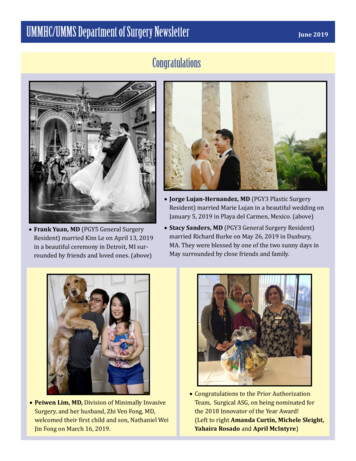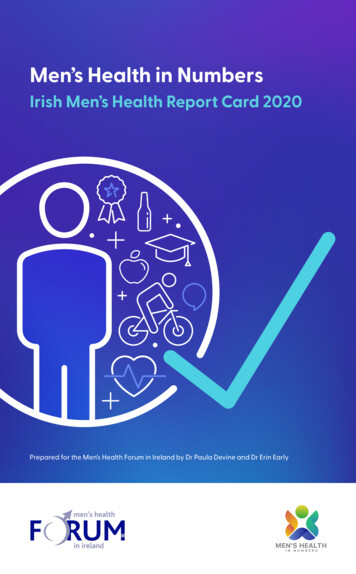
Transcription
A GUIDE FOR CARRIERS, CAREGIVERS,AND HEALTH PROFESSIONALSFRAGILE XDEPARTMENT OF HUMAN GENETICSMen’s Healthand the Fragile XPremutation
AUTHORSMatthew Walsh, MMSc, CCGStephanie L. Sherman, Ph.D.DESIGNMike Nelson Times 3PHOTOGRAPHYiStockThis book was made possible throughthe generous gift from the Fragile XAssociation of Georgia.Thanks to the men and women whograciously gave their time throughinterviews and focus groups to providetheir input about educational materialsfor premutation carriers.SECTION 01 INTRODUCTION2SECTION 02 THE FRAGILE X PREMUTATIONWhat is it and how does it work?4SECTION 03 FRAGILE X TREMOR /ATAXIA SYNDROME (FXTAS)What are the symptoms and what should I expect?11SECTION 04 TESTING FOR FRAGILE X AND FXTASWho should be tested and how?24SECTION 05 RESOURCES AND INFORMATIONHow can I learn more about FXTAS?28
01 IntroductionUp to 1 in 450 men are carriers of a genetic change called the fragile Xpremutation. Many people know about this type of genetic changein the fragile X gene because a family member may have fragile Xsyndrome, a type of intellectual disability. With increased awareness,more and more people are being diagnosed with the other disordersassociated with the fragile X gene. Families are learning that theyneed to be aware of all of the health conditions that are related tothe fragile X gene.This brochure is focused on the health of men who carry a premutation.Both men and women can be affected by this genetic change,but in different ways. So it is important for men to learn aboutpotential health problems that are specific to a fragile X premutation.It is a guide for carriers, for their families and health care providers.This book is organized in a questions and answer format. It is dividedinto 4 main sections: 1) The Fragile X Premutation: What is it andhow does it work?; 2) Fragile X Tremor/Ataxia Syndrome (FXTAS):What are the symptoms and what should I expect?; 3) Testingfor Fragile X and FXTAS: Who should be tested and how?; and4) How can I learn more about FXTAS?2
Men who carry afragile X premutationface specific healthconcerns.
02 The Fragile X PremutationWhat are genes?What happens if a geneis not working correctly?What is a fragile Xpremutation?Our bodies are made of trillions ofcells. Within each cell is our geneticmaterial, called DNA. DNA is made ofa series of small molecules. We labelthese molecules A, C, G, or T.We all have differences in our DNA.This is part of what makes us unique.If a difference occurs in one of ourgenes, it can sometimes affect theway that gene works.Sections of DNA that contain theinformation needed for our bodiesto work properly are called genes.It is sometimes helpful to think ofour genes as a set of instructions forbuilding proteins that our bodies need.These errors are sometimes called“mutations.” The errors may act likea misspelling, or a missing step, oreven extra words in the instructions.Each of these types of changes canaffect how the protein is built.Our DNA is packaged into long strandscalled chromosomes. We have 23 pairsof chromosomes in each of our cells.We receive one set of 23 chromosomesfrom one parent, and one set from ourother parent. One of these 23 pairs isdifferent and is called the sex chromosomes. Females typically have twoX chromosomes (XX) and malestypically have one X and one Ychromosome (XY).If a protein is built differently due to agenetic change, it may cause a singlehealth problem, or it may cause manyhealth problems. This all depends onthe gene that is not working properlyand the type of mutation in that gene.Mutations in the fragile X gene aretypes of changes that can affectdifferent functions in the body.The fragile X premutation is one typeof mutation within the fragile X gene.The fragile X gene is sometimescalled the FMR1 gene. It is locatedon the X chromosome, one of the sexchromosomes. This gene contains ashort section of repeated letters ofthe DNA alphabet (or code). Therepeated letters are “CGG” and arepart of the beginning of the gene.The term “repeat expansion” refersto an extra number of repeated CGGsin this part of the gene.Everyone has some number of repeatswithin this gene. Most people havebetween 20 and 35 repeated copiesof three letters (CGG) within their FMR1gene. People who have a fragile Xpremutation carry between 55 and 200copies of this CGG repeat. Up to 1 in450 men carry a fragile X premutation.People who have a premutation havea higher chance to get specific healthproblems. The number of repeats inthis premutation range is related tothe chance to develop certain healthconditions. For more informationabout premutation-related healthconditions turn to page 10.Individuals with over 200 repeats havefragile X syndrome. This type of mutation is known as a “full mutation.” Thefull mutation stops the fragile X proteinfrom being made. The full mutationcauses very different changes in thecells compared with the premutation.See page 14 for more informationabout the cell changes related to apremutation.4
Everyone inherits 23 pairs of chromosomes.The chromosomes numbered 1 to 22 are called autosomes and the last pair are the sex Y OR2323Fragile X carriers have a mutation on their X chromosome that causes an unusualnumber of repeats of CGG within the code that makes up their FMR1 gene.CGGCGGCPeople who have afragile X premutationcarry between 55 and200 copies of thisCGG repeat.GGCGGCGGCGGCGGCGGCGGCGGCGGC
Fragile X syndromeoccurs when the repeatexpansion of the FMR1gene is over 200 repeats.This is called the “fullmutation.” Fragile Xsyndrome includesintellectual disabilityand behavioral challengeslike autism, ADHD andsocial anxiety. Fragile Xsyndrome is a developmentaldisorder (meaning it startsearly in life). It is moresevere in males comparedwith females.
How did I getthe premutation?The repeat expansion is passedthrough families. The FMR1 geneis located on the X chromosome.The X and Y chromosomes are calledthe sex chromosomes. This is becausethey are involved in determiningbiological sex. Males inherit anX chromosome from their motherand a Y chromosome from their father.Females inherit an X chromosome fromeach of their parents. This is called“X-linked” inheritance. Because theFMR1 gene is on the X chromosome,there is a different inheritance patternfor men and epatternX XX YOne affected X chromosomeOne unaffected X chromosomeEqual risk of transmitting either X to childOne affected X chromosomeOne unaffected Y chromosomeWill transmit X to daughters and Y to sons50 percentof childrenwill inherit fullmutation orpremutation50 percentof childrenwill inherit theunaffected geneLet’s start with a woman who carriesa premutation. Typically, a carrierwoman has a premutation on onlyone of her X chromosomes and anormal number of repeats on theother. So, when a woman who carriesa premutation has children, she willeither pass on the X chromosomethat carries a premutation or theX chromosome that does not carrythe premutation. There is a 50% chanceof passing on either X chromosome.This is true for each pregnancy. Ifshe passes on the X chromosomethat carries a premutation, there is achance that it will expand to a highernumber of repeats. It can expandto a larger premutation or to a fullmutation. The size of the expansionwill differ with each pregnancy.Remember, fragile X syndrome iscaused by the number of repeatsexpanding to greater than 200.100 percentof daughterswill inherit apremutation100 percentof sonswill inherit theunaffected geneA man who carries a premutation onlyhas one X chromosome. This meanshe will pass on his X chromosome(which carries the premutation)to all of his daughters and to noneof his sons. His sons will receive hisY chromosome. When a man passeson his X chromosome that carries apremutation to his daughters, it rarely,if ever, expands to the full mutation.This means that a man who carries apremutation will not have a daughterwith fragile X syndrome. However,his daughter will carry a premutation.The daughter’s premutation cansometimes be larger and sometimes besmaller than her father’s premutation.7
What factors lead to theexpansion of the premutationfrom parent to child?The chance that the number of repeatsexpands to a larger number when itis passed down from parent to childdepends on a few factors. First, itdepends on the number of repeatsin the premutation of the parent.A premutation with more repeats willhave a higher chance of expanding inthe next generation. Second, the CGGrepeat sometimes includes a differentrepeat, an “AGG.” This interruptionof the CGGs by an AGG reduces thechance of a large expansion. The moreAGG interruptions a person has, thesmaller that chance of expanding toa larger number of repeats. Geneticcounselors can provide informationabout the chance that a premutationwill expand when passed from parentto child. Also, see genetic testing onpage 24 for more details.It is important to talk about your testresults with your relatives who mayalso be at risk for carrying a fragile Xmutation. A genetic counselor canhelp you understand who might beat risk in your family and can also helpyou talk with your family about thisinformation.8How do I know if I havea premutation?Why do I need to knowif I have a premutation?A fragile X premutation can bedetected through genetic testing,usually done with a simple blood test.Your doctor or genetic counselor canorder a specific type of genetic testthat looks at the number of repeatsin the FMR1 gene. Your genetic testreport will have information aboutthe name of the test, the lab thatperformed the test, and the methodused in the test. The “results” sectionof your genetic test will show howmany repeats you have in your FMR1gene. If your repeat number fallswithin 55–200 repeats, this meansthat you have a premutation.Men who have a premutation willpass it on to all of their daughtersand none of their sons. It is important for the family to understandthis inheritance pattern. Also, if youcarry a premutation, you may be atrisk for specific health conditions.Knowing if you are a carrier willhelp you and your doctor build ahealth plan.
Fragile X is a family diagnosis.
About 40 percent of men witha premutation will developFXTAS, a neurodegenerativecondition that appearslater in life and usuallyprogresses with age.
03 Fragile X Tremor/Ataxia Syndrome (FXTAS)What health concernsshould I be aware of?Men who have a premutation have achance to develop a condition calledfragile X-associated tremor/ataxiasyndrome, also known as FXTAS(pronounced FAX-tas).FXTAS is a neurodegenerative condition. This means that it affects the brainand typically gets worse over time.Symptoms of FXTAS appear later inlife and usually progress with age.The three areas that are affected byFXTAS are: 1) movement, 2) mentalhealth, and 3) the nervous system.Not everyone with a premutationdevelops FXTAS. Also, not everyonewith FXTAS will have the samesymptoms or the same severity.Someone with FXTAS may only havesome of the symptoms while othersmight have many.Why do some premutationcarriers develop FXTASand others do not?About 40% of men with a premutation develop FXTAS. This meansthat around 60% of men who have apremutation do not develop FXTAS.Researchers are working hard to figureout why some premutation carriersdo develop FXTAS, while others don’t.They do know that individuals with alarger number of premutation repeats,usually greater than 70 repeats, havea higher chance of developing FXTAS.Women who carry a premutation canalso develop FXTAS. Their symptomsmay be milder or may differ from thoseseen in men. Up to 17% of women witha premutation may develop FXTAS.The lower risk is because they haveanother X chromosome with a normalnumber of repeats. This helps reducethe risk of FXTAS-related symptoms.Knowing about the potential healthrisks of FXTAS is important for yourhealth care plan, even if you do notcurrently have any symptoms.11
What are the symptoms of FXTAS?Movement-related symptomsAs mentioned earlier, FXTAS-related symptoms varywidely. If they appear, it is usually not until after age 60,but can start in the 50’s. Sometimes symptoms get worse(progress) slowly, but sometimes they may progressquickly. At this point, the reason for these differencesis not known.ACTION TREMORHere we provide a list of symptoms that may occur anda general description of each.Tremor is involuntary muscle movement. This meansthat your muscles move when you are not trying tomake them move. Action tremor (sometimes calledintention tremor) happens when you begin to do anaction (such as trying to write with a pencil). Restingtremor occurs when the muscles are at rest and youare not trying to move. Most often, people withFXTAS have action tremors.ATAXIAAtaxia is a loss of balance and coordination. Balanceproblems may lead to needing support when walking or going up or down stairs, being unstable, andsometimes falling. To gain some stability, sometimespeople with ataxia will have a wide-based gait (thatis, walk with the feet wider apart). Many symptomsof ataxia can look like being drunk like slurredspeech, stumbling, falling, and incoordination.PARKINSONISMParkinsonism is describes a combination of themovement problems commonly seen in Parkinson’sdisease. These may include resting tremor, slowmovements, and tensed muscles also called rigidity.12
Mental health-related symptomsNervous system-related symptomsAPATHYNEUROPATHYApathy is a lack of feelings, emotions, interest orconcern. Apathy may affect your behavior and yourability to complete daily activities.Neuropathy means damage to your nerves. Thiscan lead to weakness, numbness, or pain in parts ofyour body.DISINHIBITIONERECTILE DYSFUNCTIONDisinhibition leads to the loss of ability to controlyour behavior. Someone with this condition may havea lack of impulse control and the inability to “filter”inappropriate comments.Neuropathy to the nerves of the penis can make itdifficult to get or maintain an erection.IRRITABILITY AND PERSONALITY CHANGESSomeone with FXTAS may have unstable moods.They may become more irritable or have changes inpersonality.DEPRESSIONDepression is a period of sadness lasting for morethan two weeks.BLADDER OR GASTROINTESTINAL (GI) PROBLEMSSome people with FXTAS have issues with the nervesthat control the bladder or bowels, which may leadto incontinence.ORTHOSTATIC HYPOTENSIONOrthostatic hypotension leads to a feeling ofdizziness or lightheaded when they get up from aseated or laying position.COGNITIVE DECLINE OR DEMENTIAA person with FXTAS may experience a decline intheir mental ability. This typically happens in the laterstage of the disease. It can include loss of memory(especially short term), difficulty with language, lossof focus, or difficulty with visual perception (thebrain’s ability to make sense of what the eyes see).Cognitive decline may affect a person’s ability todo everyday tasks such as reading or balancing thecheck book.13
What causes FXTAS?The exact cause of FXTAS is stillunknown. However, research tells usthat having a premutation leads totwo altered processes in the body.To understand, let’s first review moreabout genes and how they makeproteins. Remember that genesprovide the DNA code, or instructions,to build a protein. This DNA codehas to be transcribed from the DNA“language” to a different “language”that is stored in a molecule called themessenger RNA (mRNA).mRNA takes the information from theDNA and gives it to machinery that“translates” the code into buildingblocks that make up proteins. TheFMR1 gene provides the code for itsprotein, called FMRP. This protein hasmany functions. One function is to regulate the “translation” of many proteinsin the brain that help with developmentof neurons and their communication.The figure at right shows what happensto the FMR1 DNA code, the mRNAand FMRP when there is an expansionof the CGG repeats. You can see thatthe premutation and the full mutationcause completely different results.The long fragile X premutation CGGrepeat is transcribed from the FMR1gene to the FMR1 mRNA. This leadsto extra FMR1 mRNA being produced.Also, the mRNA that is produced looksdifferent because of the long CGGrepeat. Instead of remaing straight,it folds back on itself, creating a loop(sometimes called a “hairpin”).14Differences in the number of CGG repeats in the DNA sequencecause differences in the way the body creates proteins needed forcrucial processes.NormalPremutationFull mutationFewer than 54CGG repeatsin the FMR1 gene55 to 200CGG repeatsin the FMR1 geneMore than 200CGG repeatsin the FMR1 geneTranscriptionproduces normal,linear mRNATranscriptionproduces extra,differently shapedmRNAThe FMR1 geneis turned off andno mRNA is madeTranslation producesnormal amount ofFMRP proteinsTranslation producesreduced amount ofFMRP proteins
This premutation mRNA may be“toxic”to the cell in two different ways.First, the folded mRNA can attract(or sequester) other proteins to bind onto it. This causes the proteins to clumptogether to the folded mRNA. Theproteins then are not able to do theirnormal job in a cell.Second, that folded part of the mRNAcan cause the “translation” machineryto start building a new protein at thewrong place. Instead of adding building blocks from the beginning of theinstructions, the machinery starts building the protein from the wrong step.This means that new proteins are beingmade that should not be in the cell.These two events (the attraction ofproteins to the folded mRNA, and thebuilding of incorrect proteins) causethe cell to have problems. This cancause the cell to die earlier thannormal. Researchers are focusingon these events and how they maybe targeted for prevention or fortreatment.mRNA takes the information from the DNA and gives it tomachinery that translates the code into building blocks that makeup proteins.Normal mRNA forms in a straight line to present the code for translation.But the CGG repeats in the DNA causes the mRNA to fold back onto itself ina "hairpin" formation. This change in shape alters the way some proteins areprocessed in the cell.For instance, the folded mRNA attracts, or "sequesters" some proteins away fromother necesary cellular functions. The proteins then are not able to do their normal job.Also, the folded mRNA can cause the translation machinery to build new proteinsin the wrong place on the mRNA strand. These new proteins do not belong inthe cell.15
Diagnosis of FXTAScan be difficult.Work with yourneurologist to makean accurate diagnosisand obtain the careyou need.
How do I know ifI have FXTAS?For an adult who carries a premutation,FXTAS can be diagnosed by a neurologist by checking a list of specificsymptoms. The neurologist will needto take a family history, conduct aneurological examination, and requesta magnetic resonance image (MRI)to be done. Symptoms related toFXTAS are divided into two groups:“major” and “minor” symptoms. Majorsymptoms are almost always seen inindividuals with FXTAS. Minor symptoms might be seen in individuals withFXTAS, but are also sometimes part ofnormal aging in everyone.The diagnosis can sometimes be hardbecause there are many reasons forsymptoms, including natural aging.Because of this, the FXTAS diagnosismaybe be “definite”, “probable” or“possible”. This table describes thediagnostic criteria that relates to theconfidence of a diagnosis. As we gainmore knowledge about FXTAS and howit presents, these criteria may change.It is important for you and your neurologist to work together to make sureyou have an accurate diagnosis andsupportive care.CLINICALFINDINGSMINOR SYMPTOMSMAJOR SYMPTOMSModerate to severe short-termmemory deficitIntention tremorGait ataxiaExecutive function deficitNeuropathyParkinsonismBRAINFINDINGS(MRI)MRI lesions involving cerebralwhite matterMRI white matter lesions in themiddle cerebellar pedunclesModerate to severe generalizedbrain atrophy (loss of cells inthe brain)MRI white matter lesions in thesplenium of the corpus callosumDIGNOSTIC CRITERIAPOSSIBLEPresence of 1 major radiological sign plus 1 major clinical symptomPROBABLEPresence of either 1 major radiological sign plus 1 major clinicalsymptom or 2 major clinical symptomsDEFINITEPresence of 1 major radiological sign plus 1 major clinical symptom17
What should I do if I am experiencingany of these symptoms?Individuals with FXTAS can benefit from havinga healthcare team made up of various specialists.All individuals with FXTAS should see a neurologist.A neurologist with experience in movement disorderscan help treat some of the symptoms of FXTAS.GENETIC COUNSELORGenetic counselors are healthcareproviders who can help individualsand their families understand thegenetics of the fragile X mutation andadapt to the medical, psychologicaland familial aspects of the associateddisorders.Your healthcare team will depend on your specificsymptoms and diagnosis, and may include specialistsin the following fields:PHYSICAL THERAPISTPhysical therapists are experts inphysical movement. They will helpto improve quality of life throughexercise, hands-on care, andpatient education.18
NEUROLOGISTAll individuals with FXTAS shouldsee a neurologist. A neurologistwith experience in movementdisorders can help treat some ofthe symptoms of FXTAS.SPEECH AND LANGUAGE THERAPISTSpeech and language therapistscan help prevent and treatproblems with speech, language,and swallowing.YOUSOCIAL WORKEROCCUPATIONAL THERAPISTSocial workers help individuals,families, and their communitiesdevelop skills to use their resourcesto solve problems in their own lifeand in their social lives. Their goalis to increase overall well-being.Occupational therapists helppeople fully take part in daily life.This includes activites at home,at work and at play. Their goal is topromote a person’s independenceas much as possible.19
What can I expect if I amdiagnosed with FXTAS?FXTAS is a progressive disease. Thismeans that the symptoms may getworse over time. Not everyone withFXTAS will have the same experience.Some people may have a very slowand stable progression of the disease.Others may decline more quickly.The first symptom of FXTAS is usuallyaction tremors in their upper limbs.Tremor means that your muscles movewithout you telling them to. Somesigns of tremor might be hard to noticeat first. You may have difficulty keepingyour hands steady when you do anactivity. As the tremor gets worse,people may have a hard time withactivities of daily living. These mayinclude writing, eating, dressingyourself, or bathing yourself. If thetremor gets much worse, people mayneed help with their daily activitiesand tasks.20Does FXTAS have a cure?Following the presence of tremors,people may have trouble with balanceand coordination (called ataxia).Sometimes, balance problems arenoticed before tremors. Ataxia maycause a person to walk differently orto be less coordinated when doingphysical activities. Balance problemscan lead to falling. If ataxia gets worse,a person may need a walking aid(like a cane or walker). Some peoplewith severe ataxia may eventuallyneed a wheelchair.It is difficult to predict if or whensomeone with FXTAS may developsymptoms of cognitive decline ordementia. If you or your familymembers are concerned, a neurologistcan test your cognitive functioningand suggest possible strategies toreduce the effects of decline.There currently is no cure for FXTAS.However, your doctor may be ableto treat some of the symptoms ofFXTAS to improve daily activitiesand well-being.What can I do to slowthe progression of FXTAS?Doctors recommend a healthy lifestyle,with minimal stress. Of course thisis true for everyone. But for those atrisk for FXTAS, this might be moreimportant.
For men at risk,a lifestyle that includesexercise, healthy diet,and minimizing stressis especially important.
These conversations are not easy,but it is important to have themwhile you are able to make yourwishes known.How can I plan for the future?Not everyone with a premutation will develop FXTAS. Andnot everyone with a diagnosis of FXTAS will have the samedisease progression. However, planning may be helpful foryou and your family to be ready for whatever the futureholds. Planning the future with FXTAS in mind may be similar to planning for old age, only sooner. Topics to think aboutmay include health-related planning, social planning, homemodifications, legal planning, and end of life issues.Health-related planning involves putting together yourhealth-care professional team. This includes finding a neurologist or movement disorders specialist, getting in touch witha social worker, and speaking with a geneticist or geneticcounselor. (see page xxx for more information)Social planning may include discussing caregiving responsibilities and responsibilities around the house such as yardwork, maintenance, paying bills, cooking, and cleaning.Home modifications may help a person with FXTAS stayindependent for longer and may prevent accidents. Occupational therapist may be able to help with suggestions of modifications. Not everyone chooses to modify their home. Instead, they may choose to move to a new house (for example,a house with one floor) or to an assisted-living community.Legal planning involves putting together important documents known as “advance directives”. These might includesetting up long-term care, creating a living will, or talkingabout medical and legal power of attorney. Finding a lawyerwho specializes in elder-care law may be helpful.Talking about end of life issues is another part of planningfor the future for everyone, not just those with FXTAS. Thesetopics may be difficult to discuss, but it is important to havethem while you are able to make your wishes known.[picture of someone sitting with a lawyer?]Page break
How can I plan forthe future?Not everyone with a premutation willdevelop FXTAS. And not everyonewith a diagnosis of FXTAS will have thesame disease progression. However,planning may be helpful for you andyour family to be ready for whateverthe future holds. Planning the futurewith FXTAS in mind may be similarto planning for old age, only sooner.Topics to think about may includehealth-related planning, socialplanning, home modifications, legalplanning, and end of life issues.Health-related planning involvesputting together your health-careprofessional team. This includes findinga neurologist or movement disordersspecialist, getting in touch with a socialworker, and speaking with a geneticistor genetic counselor. See page 18for more information.Social planning may include discussingcaregiving responsibilities and responsibilities around the house such asyard work, maintenance, paying bills,cooking, and cleaning.Home modifications may help a personwith FXTAS stay independent forlonger and may prevent accidents.Occupational therapists may be able tohelp with suggestions of modifications.Not everyone chooses to modify theirhome. Instead, they may choose tomove to a new house (for example,a house with one floor) or to anassisted-living community.Legal planning involves puttingtogether important documents knownas “advance directives.” These mightinclude setting up long-term care,creating a living will, or talking aboutmedical and legal power of attorney.Finding a lawyer who specializes inelder-care law may be helpful.Talking about end of life issues isanother part of planning for thefuture for everyone, not just those withFXTAS. These topics may be difficultto discuss, but it is important to havethem while you are able to make yourwishes known.23
04 Testing for a Fragile X Mutation and FXTASWho should be testedfor a fragile X premutationand for FXTAS?Anyone who has a family memberdiagnosed with a fragile X-associateddisorder or a fragile X mutation maywant to be tested. The three wellestablished fragile X-associateddisorders include: fragile X syndrome(due to a full mutation), FXTAS (dueto a premutation), and specifically forwomen, fragile X-associated primaryovarian insufficiency (FXPOI) (due toa premutation). A fragile X mutationcan be identified using a simplegenetic test. See page 8 for furtherdetails.Sometimes a person may havepossible symptoms of FXTAS, butno one in their family has been testedfor a fragile X-associated disorder.In this case, their doctor needs toconsider all the possible causes fortheir patient’s symptoms, one of whichcould be FXTAS. A set of guidelinesare provided here to help healthcareproviders decide whether theirpatient should be tested for a fragile Xpremutation. Although there are nospecific treatments for FXTAS, it isimportant for doctors to identify whichof their patient’s symptoms are causedby a genetic condition. This can helptheir patient understand the reasonfor their symptoms and inform theirfamily members. It is also importantto connect their patient to specialistsand other families who haveexperience with FXTAS.24Clinicians should test for a fragile X mutation if their patient has any of thefollowing:CEREBELLARATAXIAIf symptoms start at age 50 or older and the cause is unknown.ACTIONTREMORIf symptoms start at age 50 or older, the cause is unknown andif they occur along with cerebellar ataxia, parkinsonism, orcognitive decline.DEMENTIAIf symptoms start at age 50 or older, the cause is unknown andif symptoms also include cerebellar ataxia, parkinsonism, oraction tremor.MULTIPLESYSTEM ATROPHYCEREBELLARSUBTYPEEspecially if a prolonged course.SOME SYMPTOMSPLUS FAMILYHISTORYSymptoms of FXTAS and a family history of ovarian insufficiency(including infertility) or intellectual disability or autism spectrumdisorder or family history fragile X syndrome, FXPOI, or FXTAS.
Family membersmay want to considergenetic testing,even if they do nothave symptomsof FXTAS.
Good communicationbetween patient, family,clinicians, and caregiversis essential when dealingwith a FXTAS diagnosis.
Co
This brochure is focused on the health of men who carry a premutation. Both men and women can be affected by this genetic change, but in different ways. So it is important for men to learn about potential health problems that are specific to a fragile X premutation. It is a guide for carriers, for t










